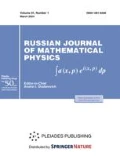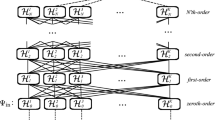Abstract
One shows that the Feynman’s Path Integral designed for quantum mechanics has an analogous in classical mechanics, the so-called (min, +) Path Integral. This former is build on (min, +)-algebra and (min, +)-analysis which permit to handle in a linear way non-linear problems occurring in mathematical physics. The Hamilton-Jacobi equations and their solutions within this mathematical framework, are introduced and yield to a new interpretation expressed in a duality between action field and particle.
Similar content being viewed by others
References
B. A. Carré, “An Algebra for Network Routing Problems,” J. Inst. Math. Appl. 19, pp. 381 (1971).
R. Bellman, Dynamic Programming (Princeton University, Princeton, 1957).
M. Kalinski, J. H. Eberly, and I. Bialynicki-Birula, “Lagrange Equilibrium Points in Celestial Mechanics and Nonspreading Wave Packets for Strongly Driven Rydberg Electrons,” Phys. Rev. Lett. 73, pp. 1777 (1994).
D. Bohm, “A Suggested Interpretation of the Quantum Theory in Terms of “Hidden” Variables,” Phys. Rev. 85, 166–193 (1952).
D. Delande and A. Buchleitner, “Non-Dispersive Electronic Wave Packets in Multiphoton Processus,” Phys. Rev. Lett. 75, pp. 1487 (1995).
D. Delande, J. Zakrzewski, and A. Buchleitner, “Non-Dispersive Wave Packets in Periodically Driven Quantum Systems,” Phys. Rep. 368, 409–547 (2002).
C. Benzaken, Structure algébrique des cheminements: pseudotreillis, gerbier de carré nul in: Biorcu G. 5 Ed. Networks and swatching theory, Academic Press, 1968.
A. P. Demichev and M. Chaichian, Path Integrals in Physics, Vol. 1 : Stochastic Process and Quantum Mechanics (Taylor, Francis, 2001).
P. Hervé and R. Cruon, Quelques résultats relatifs à une structure algébrique et son application au problème central de l’ordonnancement (1965).
L. de Broglie, “La mécanique ondulatoire et la structure atomique de la matière et du rayonnement,” Journal de Physique 8, 225–241 (1927).
L. Euler, Methodus Inveniendi Lineas Curvas Maximi Minive Proprietate Gaudentes (Bousquet, Lausanne et Geneva, 1744).
R. Feynman and A. Hibbs, Quantum Mechanics and Path Integrals (McGraw-Hill, 1965).
R. Feynman and A. Hibbs, “Quantum Mechanics and Path Integrals,” McGraw-Hill, 41–64 (1965).
R. Feynman and A. Hibbs, “Quantum Mechanics and Path Integrals,” McGraw-Hill, 58–60 (1965).
R. P. Feynman, “Space-Time Approach to Non-Relativistic Quantum Mechanics,” Rev. Modern Phys. 20(2), 367–387 (1948).
G. L. Litvinov, “The Maslov Dequantization, Idempotent and Tropical Mathematics: A Brief Introduction,” J. Math. Sci. 140(3), 426–444 (2007).
R. J. Glauber, Quantum Optics and Electronics, Les Houches Lectures 1964, C. de Witt, A. Blandin and C. Cohen-Tanoudji (Gordon and Breach, New York, 1965).
M. Gondran, “Analyse Minplus,” C. R. Acad. Sci. Paris 323, 371–375 (1996).
M. Gondran, “Convergences de fonctions à valeurs dans ℝk et analyse minplus complexe,” C. R. Acad. Sci. Paris 329, 783–788 (1999).
A. Gondran and M. Gondran, “Discerned and Non-Discerned Particles in Classical Mechanics and Convergence of Quantum Mechanics to Classical Mechanics,” Annal. Fond. Louis de Broglie 39, 117–135 (2011).
A. Gondran and M. Gondran, “The Two Limits of the Schrödinger Equation in the Semi-Classical Approximation: Discerned and Non-Discerned Particles in Classical Mechanics,” Foundations of Probability and Physics-6, AIP Conf. Proc. 1424, 111–115 (2012), 1424, 111–115 (2012).
I. Tomescu, Sur les méethodes matricielles dans la théeorie des réeseaux (1966).
J. Kutzman, Théeorie des reéseaux graphes (Dunod, Paris, 1972).
J. L. Lagrange, Méecanique Analytique (Gauthier-Villars, Paris, translated by V. Vagliente and A. Boissonade (Klumer Academic, Dordrecht, 2001)), 2nd edition, 1888.
M. Gondran, Problèemes combinatoires et programmation en nombres entiers. Theèse de Doctorat d’Etat (University of Paris VI, 1974).
M. Gondran, “L’algorithme glouton dans les algèbres de chemin,” Bull. Etudes et de la Recherche, EDF, Séerie C 1, 25–32 (1975).
M. Gondran, “Path Algebra and Algorithms,” B. Roy (Ed.), Combinatorial Programming: Methods and Applications, Reidel, Dordrecht, 137–148 (1975).
M. Gondran, “Valeurs propres et vecteurs propres en classification hiérarchique,” RAIRO-Theoretical Informatics and Applications 10(1), 39–46 (1976).
M. Gondran, “Les éléments p-réguliers dans les dioïdes,” Discrete Math. 25, 33–39 (1979).
M. Gondran, “Valeurs propres et vecteurs propres en analyse des préeféerences,” Note EDF, pages HI–3199 (1979).
A. Gondran, M. Gondran, and A. Kenoufi, “Complex Variational Calculus with Mean of (Min, +)-Analysis,” Trends Appl. Comput. Math. 18(3), 1–19 (2017).
A. Kenoufi and M. Gondran, “Numerical Calculations of Hölder Exponents for the Weierstrass Functions with (Min,+)-Wavelets,” Trends Appl. Comput. Math. 15 (3), 261–273.
M. Minoux and M. Gondran, Graphs and Algorithms (Wiley-Interscience, 1984).
M. Minoux and M. Gondran, Graphs, Dioids and Semirings (Springer, 2008).
T. Lehner, M. Gondran, and A. Kenoufi, “Multi-Fractal Analysis for Riemann Serie and Mandelbrot Binomial Measure with (min, +)-Wavelets,” Trends Appl. Comput. Math. 17(2), 247–263 (2016).
E. Madelung, “Quantentheorie in Hydrodynamischer Form,” Zeit. Phys. 40, 322–6 (1926).
T. F. Gallagher and H. Maeda, “Non Dispersing Wave Packets,” Phys. Rev. Lett. 92, 133004–1 (2004).
V. Maslov, Operational calculus (Mir, Moscow, 1987).
P. Del Moral, A survey of Maslov optimization theory (V. N. Kolokoltsov and V. P. Maslov, Idempotent Analysis and Applications, Kluwer Acad. Publ., Dordrecht, 1997).
J. Ferland and P. Robert, Généralisation de l’algorithme de warshall (1968).
E. Schrödinger, “Der stetige Bergang von der mikro-zur Makromechanik,” Naturwissenschaften 14, 664–666 (1926).
L. S. Schulmann, Techniques and Applications of Path Integration (John Wiley & Sons, New York, 1981).
V. Peteanu, An Algebra of the Optimal Path in Networks (1967).
S. N. Samborski and V. P. Maslov, Idempotent Analysis (Advances in Soviet Mathematics, Amer. Math. Soc., 13, 1992).
J. H. Van Vleck, “The Correspondence Principle in the Statistical Interpretation of Quantum Mechanics,” Proc. Natl. Acad. Sc. USA 14(2), 178–188 (1928).
V. N. Kolokoltsov and V. P. Maslov, Idempotent Analysis and Its Applications in Optimal Control (Nauka, 1994).
Acknowledgements
We thank Professors Lyazid Chetouani, Janos Polonyi, and René Voltz for interesting and useful discussions about path integrals and least-action principles.
Author information
Authors and Affiliations
Corresponding authors
Rights and permissions
About this article
Cite this article
Kenoufi, A., Gondran, M. & Gondran, A. Semi-Classical Limit and Least Action Principle Revisited with (min,+) Path Integral and Action-Particle Duality. Russ. J. Math. Phys. 27, 61–75 (2020). https://doi.org/10.1134/S1061920820010069
Received:
Revised:
Accepted:
Published:
Issue Date:
DOI: https://doi.org/10.1134/S1061920820010069



